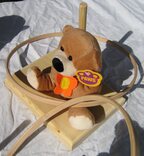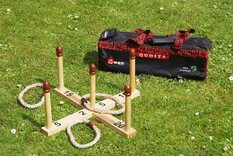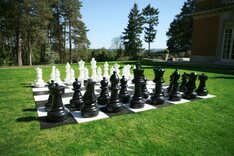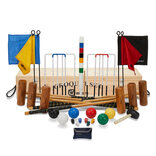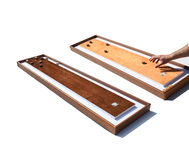Quoits Games
The traditional game of Quoits has a long history. The old game, still played in certain British pubs, uses steel quoits that are thrown at metal pins embedded in beds of soft clay. During the last couple of centuries, various indoor versions of quoits appeared. We have Deck Quoits, popular on cruise liners from the early 1900s, Evesham Quoits - a pub game which is a miniaturised version of the outdoor sport as well as the great old game of Rings.
Single Stake Quoits
Multiple Stake Quoits
We recommend single stake Quoits as it is more skillful and we think more enjoyable. However, children may prefer the variety of multiple stake quoits below. This form of quoits emerged as a parlour game in Victorian times.
The traditional game of Quoits has a long and venerable history. The full game is played outdoors using iron or steel quoits that are thrown at metal pins embedded in beds of soft clay. Although a beginner will always aim for a "ringer", the game is very tactical and a ringer is not always the best shot - expert players will often attempt to "cover" the pin with a the top of a quoit sticking out of the clay in order to prevent their opponent from being able to place a better quoit. A well aimed quoit can deliberately flip an opponent's quoit out of the way. Two versions of traditional outdoor Quoits are played - "The Northern Game" played in the North of England and "The Long Game" played in Scotland, Wales and North Suffolk, England. The Long Game is as much a test of strength as skill with heavy metal quoits weighing up to 10lb being tossed 18 or 21 yards at a pin that is flush with the clay and consequently barely visible. Scotland and Wales still play an international once a year. In England, the Long game only survives in any major form in Suffolk where somewhat different rules and lighter quoits lend a quite different flavour. More popular in England is the Northern Game which is played at the shorter distance of 11 yards and features a pin that sticks slightly out of the ground so a ringer properly encircles the stake. The game is more tactical because only the top ringer scores which obviously gives a nominal advantage to the player who tosses second. The first player therefore usually endeavours to block the second player's quoit by a covering the pin with the body of the quoit or maybe by positioning a quoit right in front of the stake. You can learn more about the History of Quoits from the Online Guide to Traditional Games.




